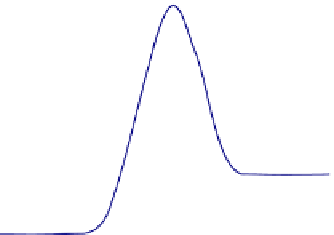Biomedical Engineering Reference
In-Depth Information
where k* is a constant. While this approach has its merit, we have three unknowns: k*,
D
G
f
,
and
D
G
b
, all of which may be dependent on the reaction path.
It is found empirically that the reaction rate coefficients frequently depend on tempera-
ture as
k
T
¼
e
E=RT
k
(3.53)
0
where E is called the activation energy for the reaction and k
0
is called the pre-exponential factor.
This relation is credited to Svante Arrhenius and is called the Arrhenius law. Arrhenius was
mainly concerned with thermodynamics and chemical equilibrium. Some time later, Michael
Polanyi and Eugene Wigner showed that simple molecular arguments lead to this temperature
dependence, and so this form of the rate is frequently called the Polanyi
e
Wigner relation.They
described chemical reactions as the process of crossing a potential energy surface between reac-
tants and products (see
Figs 3.2 and 3.3
), where E
f
and E
b
are the energy barriers for the forward
and reverse reactions,
D
H
R
is the heat of the reaction (to be discussed later), and the horizontal
scale is called the reaction coordinate, the loosely defined distance that molecules must travel to
convert from reactants to products. Polanyi andWigner first showed from statistical mechanics
that the rates should be described by expressions of the formgiven in Eqn
(3.53)
by a Boltzmann
factor, exp(
E/RT), which is the probability of crossing a potential energy barrier between
product and reactant molecules. In fact, it is very rare ever to find reaction rate coefficients
that cannot be described with fair accuracy by expressions of this form.
This functional form of k(T) predicts a very strong dependence of reaction rates on temper-
ature, and this fact is central in describing the complexities of chemical reactions, as we will
see throughout this topic.
Example 3-2. How much does a reaction rate with an activation energy of 15,000 cal/mol
vary when the temperature is increased from 300 to 310 K? From 300 to 400 K?
FIGURE 3.3
Plot of potential energy of reactants and products in a chemical reaction vs the reaction coordinate.
Although the free energy always decreases after the reaction (
Fig. 3.2
), the internal energy can be increased
(endothermic reactions) or decreased (exothermic reactions). The activation energy for the forward reaction is E
f
and
for the back reaction E
b
. The heat of the reaction is
D
H
R
¼
E
b
. (a). Potential energy variation for an exothermic
reaction based on 1 mol of substrate. (b). Potential energy variation for an endothermic reaction based on 1 mol of
substrate.
E
f













































Search WWH ::

Custom Search